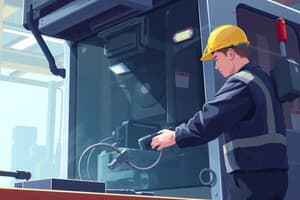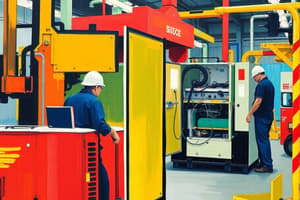Podcast
Questions and Answers
What is involved in the design of work organisation to prevent manual handling injuries?
What is involved in the design of work organisation to prevent manual handling injuries?
- Only workstation layout and plant equipment
- Supervision and instruction only
- Only providing mechanical lifting devices and training
- Workstation layout, plant, equipment, containers, and manual handling techniques (correct)
What is the primary reason for adopting preferred lifting, moving, and handling techniques?
What is the primary reason for adopting preferred lifting, moving, and handling techniques?
- To prevent permanent disabilities and reduce workdays lost (correct)
- To reduce the cost of mechanical lifting devices
- To reduce the number of workers required for team lifting
- To enable workers to lift heavier objects
Which of the following is NOT a necessary measure when manual handling cannot be designed out of work?
Which of the following is NOT a necessary measure when manual handling cannot be designed out of work?
- Ensuring workers wear protective clothing (correct)
- Providing mechanical lifting devices
- Supervision to enable workers to work safely
- Providing adequate information and training
Who should be involved in discussions about the workplace's manual handling policy?
Who should be involved in discussions about the workplace's manual handling policy?
What is the primary cause of industrial accidents and permanent disabilities in the workplace?
What is the primary cause of industrial accidents and permanent disabilities in the workplace?
Why is it important to provide a combination of measures when manual handling cannot be designed out?
Why is it important to provide a combination of measures when manual handling cannot be designed out?
What can attitudes that do not support safe behaviour lead to?
What can attitudes that do not support safe behaviour lead to?
What is the primary factor that shapes your motivation?
What is the primary factor that shapes your motivation?
Which of the following is a medical factor that can cause accidents?
Which of the following is a medical factor that can cause accidents?
What is the result of having positive motivations towards job safety?
What is the result of having positive motivations towards job safety?
What is the relationship between attitudes and motivations?
What is the relationship between attitudes and motivations?
Which of the following is an undesirable motivation that can lead to accidents in the workplace?
Which of the following is an undesirable motivation that can lead to accidents in the workplace?
What is the primary purpose of universal symbols on picture safety signs in workshops?
What is the primary purpose of universal symbols on picture safety signs in workshops?
What is the effect of using colour on safety signs?
What is the effect of using colour on safety signs?
What is the significance of the colour red on safety signs?
What is the significance of the colour red on safety signs?
What is the ultimate goal of using safety signs and colours in the workplace?
What is the ultimate goal of using safety signs and colours in the workplace?
How many basic sign categories are there?
How many basic sign categories are there?
What distinguishes each sign category?
What distinguishes each sign category?
What is the primary benefit of controlling manual handling risks in the workplace?
What is the primary benefit of controlling manual handling risks in the workplace?
What is the most common type of injury caused by improper manual handling?
What is the most common type of injury caused by improper manual handling?
What is the primary reason why the spine is not suited to lifting loads when the upper part of the body is acutely bent or twisted?
What is the primary reason why the spine is not suited to lifting loads when the upper part of the body is acutely bent or twisted?
What percentage of all disc injuries occur in the three lowest discs?
What percentage of all disc injuries occur in the three lowest discs?
What happens to the inter-vertebral discs when you lift with a bent back?
What happens to the inter-vertebral discs when you lift with a bent back?
What is the recommended posture for lifting loads?
What is the recommended posture for lifting loads?
What should you do if you have the authority to correct an unsafe condition?
What should you do if you have the authority to correct an unsafe condition?
Why is it important to correct the problem at the source?
Why is it important to correct the problem at the source?
What should you do if you do not have the authority to correct an unsafe condition?
What should you do if you do not have the authority to correct an unsafe condition?
Why is it important to offer suggestions about how to correct an unsafe condition?
Why is it important to offer suggestions about how to correct an unsafe condition?
What is the purpose of taking temporary precautions when correcting an unsafe condition?
What is the purpose of taking temporary precautions when correcting an unsafe condition?
Why is it important to correct the problem at the source rather than just correcting the unsafe condition?
Why is it important to correct the problem at the source rather than just correcting the unsafe condition?
Flashcards are hidden until you start studying
Study Notes
Importance of Rhythmic Movements in Manual Handling
- Adopting rhythmic movements in manual handling reduces back injuries and improves productivity and efficiency in the workplace
- Sudden or jerky movements should be avoided to minimize the risk of back injuries
Spine and Manual Handling
- The spine is not suited to lifting loads when the upper part of the body is acutely bent or twisted
- Bent lifting puts stress on the lumbar discs, and 95% of disc injuries occur in the three lowest discs
- Straight-back lifting reduces the stress on the lumbar discs and prevents disc injuries
Disc Compression and Rupture
- Lifting with a bent back compresses the inter-vertebral discs and stretches them over the back of the spine
- This can cause disc rupture and spinal injury
Attitudes and Motivations
- Attitudes that do not support safe behavior hamper accident prevention and can cause accidents
- Positive motivations towards job safety are crucial in preventing accidents
- Undesirable motivations, such as saving time and gaining approval, can lead to accidents
Medical Factors and Accidents
- Medical factors, such as illness, impairment, and fatigue, can cause accidents in the workplace
- These factors can be associated with high-tempos of operations, lack of rest, and inadequate nourishment
Correcting Unsafe Conditions
- Four avenues are available to correct unsafe conditions: ordering correction, reporting to higher authority, correcting the problem at the source, and taking temporary precautions
- Correcting the problem at the source involves identifying and addressing the root cause of the hazard
Designing Out Manual Handling
- Employers must provide mechanical lifting devices, team lifting procedures, and adequate information and training to minimize manual handling risks
- Discussions among workers, health and safety representatives, and employers are essential in setting out the workplace's manual handling policy
Manual Handling Injuries
- Manual handling leads to a large number of industrial accidents, including strained backs, damaged spinal discs, and injured hands and feet
- Adopting preferred lifting, moving, and handling techniques is crucial in preventing injuries
Safety Signs and Colours
- Safety signs and colours are essential in warning of hazards and preventing accidents
- Standard symbols and colour markings are used to convey important safety information
- There are three basic sign categories: regulatory, warning, and information
Studying That Suits You
Use AI to generate personalized quizzes and flashcards to suit your learning preferences.




